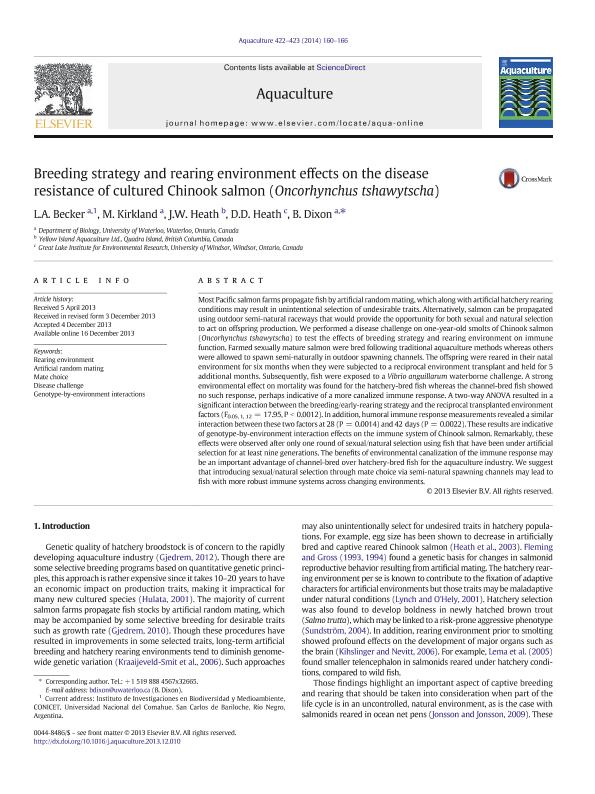Artículo
Breeding strategy and rearing environment effects on the disease resistance of cultured Chinook salmon (Oncorhynchus tshawytscha)
Fecha de publicación:
02/2014
Editorial:
Elsevier
Revista:
Aquaculture
ISSN:
0044-8486
Idioma:
Inglés
Tipo de recurso:
Artículo publicado
Clasificación temática:
Resumen
Most Pacific salmon farms propagate fish by artificial random mating, which along with artificial hatchery rearing conditions may result in unintentional selection of undesirable traits. Alternatively, salmon can be propagated using outdoor semi-natural raceways that would provide the opportunity for both sexual and natural selection to act on offspring production. We performed a disease challenge on one-year-old smolts of Chinook salmon (Oncorhynchus tshawytscha) to test the effects of breeding strategy and rearing environment on immune function. Farmed sexually mature salmon were bred following traditional aquaculture methods whereas others were allowed to spawn semi-naturally in outdoor spawning channels. The offspring were reared in their natal environment for six months when they were subjected to a reciprocal environment transplant and held for 5 additional months. Subsequently, fish were exposed to a Vibrio anguillarum waterborne challenge. A strong environmental effect on mortality was found for the hatchery-bred fish whereas the channel-bred fish showed no such response, perhaps indicative of a more canalized immune response. A two-way ANOVA resulted in a significant interaction between the breeding/early-rearing strategy and the reciprocal transplanted environment factors (F0.05, 1, 12 = 17.95, P b 0.0012). In addition, humoral immune response measurements revealed a similar interaction between these two factors at 28 (P = 0.0014) and 42 days (P = 0.0022). These results are indicative of genotype-by-environment interaction effects on the immune system of Chinook salmon. Remarkably, these effects were observed after only one round of sexual/natural selection using fish that have been under artificial selection for at least nine generations. The benefits of environmental canalization of the immune response may be an important advantage of channel-bred over hatchery-bred fish for the aquaculture industry. We suggest that introducing sexual/natural selection through mate choice via semi-natural spawning channels may lead to fish with more robust immune systems across changing environments.
Archivos asociados
Licencia
Identificadores
Colecciones
Articulos(INIBIOMA)
Articulos de INST. DE INVEST.EN BIODIVERSIDAD Y MEDIOAMBIENTE
Articulos de INST. DE INVEST.EN BIODIVERSIDAD Y MEDIOAMBIENTE
Articulos(SEDE CENTRAL)
Articulos de SEDE CENTRAL
Articulos de SEDE CENTRAL
Citación
Becker, Leandro Anibal; Kirkland, M.; Heath, J. W.; Heath, D. D.; Dixon, B.; Breeding strategy and rearing environment effects on the disease resistance of cultured Chinook salmon (Oncorhynchus tshawytscha); Elsevier; Aquaculture; 422-423; 2-2014; 160-166
Compartir
Altmétricas




